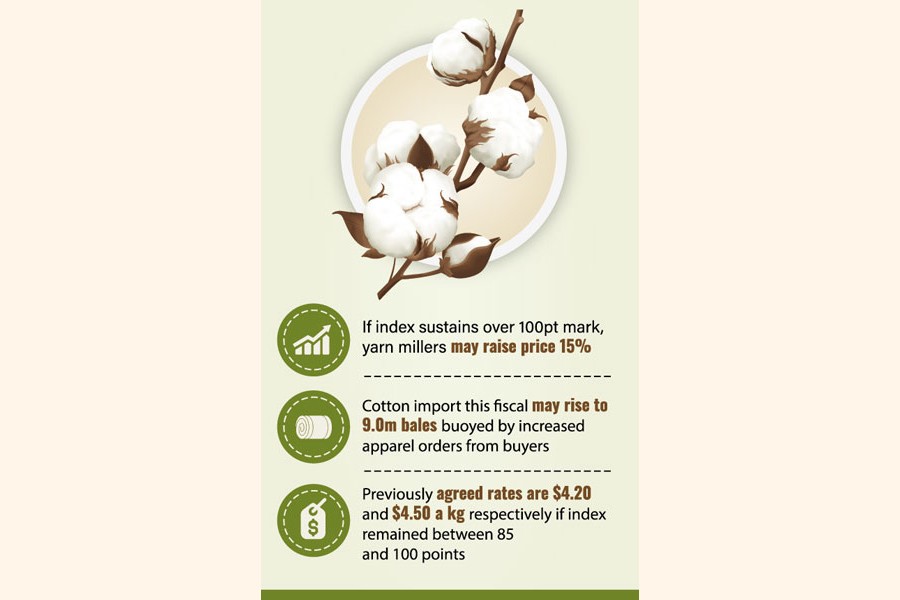
Decade-high cotton prices set to make RMG costlier
Textile millers advise garment exporters to renegotiate apparel rates
FE REPORT | Wednesday, 6 October 2021

Bangladesh's main export, readymade garment, is poised to be costlier as global cotton-price index hit a decade-high with its cascading impact on the entire industrial chain, textile makers warn.
Bangladesh Textile Mills Association (BTMA) Tuesday said the price spiral of imported cotton could boost the price of locally produced yarns by 15 per cent, and, in turn, it would add up to the prices of exportable readymade garment products.
They asked the apparel exporters to take care to negotiate garment prices with the foreign buyers for a raise to make up for the possible production-cost hike.
The primary textile millers' association-BTMA-advised the garment exporters to be cautious about pricing at the time of taking fresh orders from their respective buyers.
The global cotton index remained below 100 points in August and jumped over the mark at the end of last month and hit 107 points on October 01, BTMA president Mohammad Ali Khokon said at a press conference held on the day at its office in Dhaka.
This day (October 04) in 2012, the cotton index counted 72.65 points, he added.
"The 107-point index is the highest during the last one decade and we will observe the trend for next 15 days. If the index sustains over 100-point marks, we will have no other choice but raise the rate by additional 15 per cent," he said.
The locally produced yarn prices might have the hike when delivered in November and December, he said, adding that local spinners have hardly any control over fixing yarn price as cotton is an international commodity.
Though cotton is an agricultural produce, being an industrial raw material, the 'white fibre/gold' has huge global demand compared to its production, he explained.
Besides, textile mills, especially those run with captive power generation, are facing acute shortage of gas in recent months, resulting in failure to operate to full production capacity.
Millers set the yarn price taking the additional cost into account, the leader of the main backward-linkage industry to RMG told the media.
Mr Khokon said they were worried that they might not continue with the previously set yarn price that was fixed in consultation with leaders of Bangladesh Garment Manufacturers and Exporters Association (BGMEA) and Bangladesh Knitwear Manufacturers and Exporters Association.
The BTMA president called on the local garment exporters to take the latest cotton-price index into consideration in negotiation of their fresh export orders, saying that increased supply orders are coming to Bangladesh in recent months followed by improved Covid situation in the western markets and growing demands.
Earlier on August 21, textile millers and apparel exporters unanimously fixed the upper ceiling of the mostly consumed 30-carded and 30-combed yarn prices at US$4.20 and $4.50 a kilogram respectively provided the price index remained between 85 and 100 points.
They also reached a consensus that yarn price will increase or decrease if the index crossed 100 points and went below 85.
The consensus came after apparel-and home-textile makers raised concern over the high price of yarn on the domestic market and wrote to the government authorities concerned for allowing import of the RMG raw materials, including cotton, yarn and fabrics, through all land-border ports and partial shipment of those imports.
The BTMA on August 10 also advised its export-oriented yarn makers for keeping the PI valid for at least 15 days instead of previous seven days.
PI is an estimated invoice sent by a seller to a buyer in advance of a shipment or delivery of goods.
According BTMA, Bangladesh imported about 8.2 million bales of cotton in 2020-21 fiscal, up from 7.5 million bales in FY of 2019-20.
Out of the 8.2 million bales of cotton, some 37.06 per cent were imported from African countries in the last fiscal while India accounted for 26 per cent followed by 11.35 per cent from CIS countries, 11.14 per cent from the US and 4.65 from Australia, BTMA data showed.
The textiles association fears that, this fiscal, cotton import might reach 9.0 million bales buoyed by the increase in apparel orders from the global market, where, reports say, stores remained empted after the reopening of economy following the lifting of anti-corona lockdowns.
Munni_fe@yahoo.com